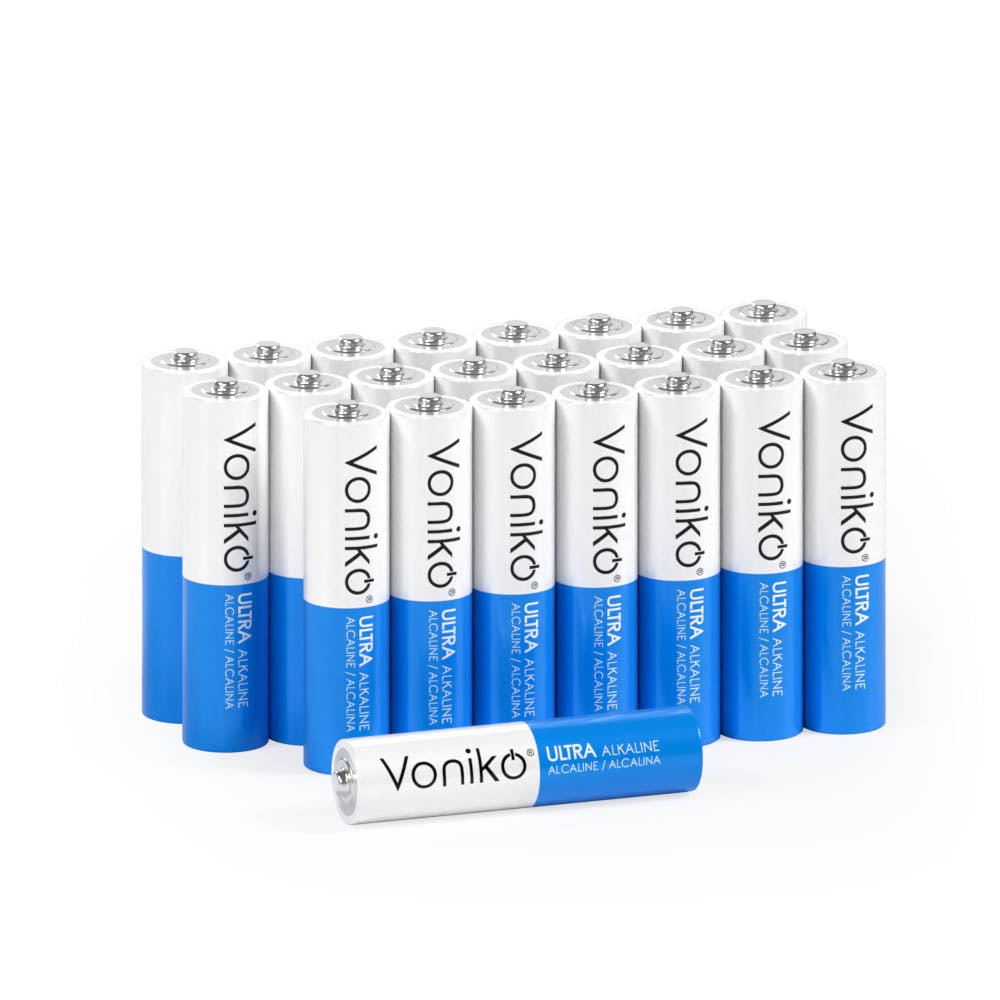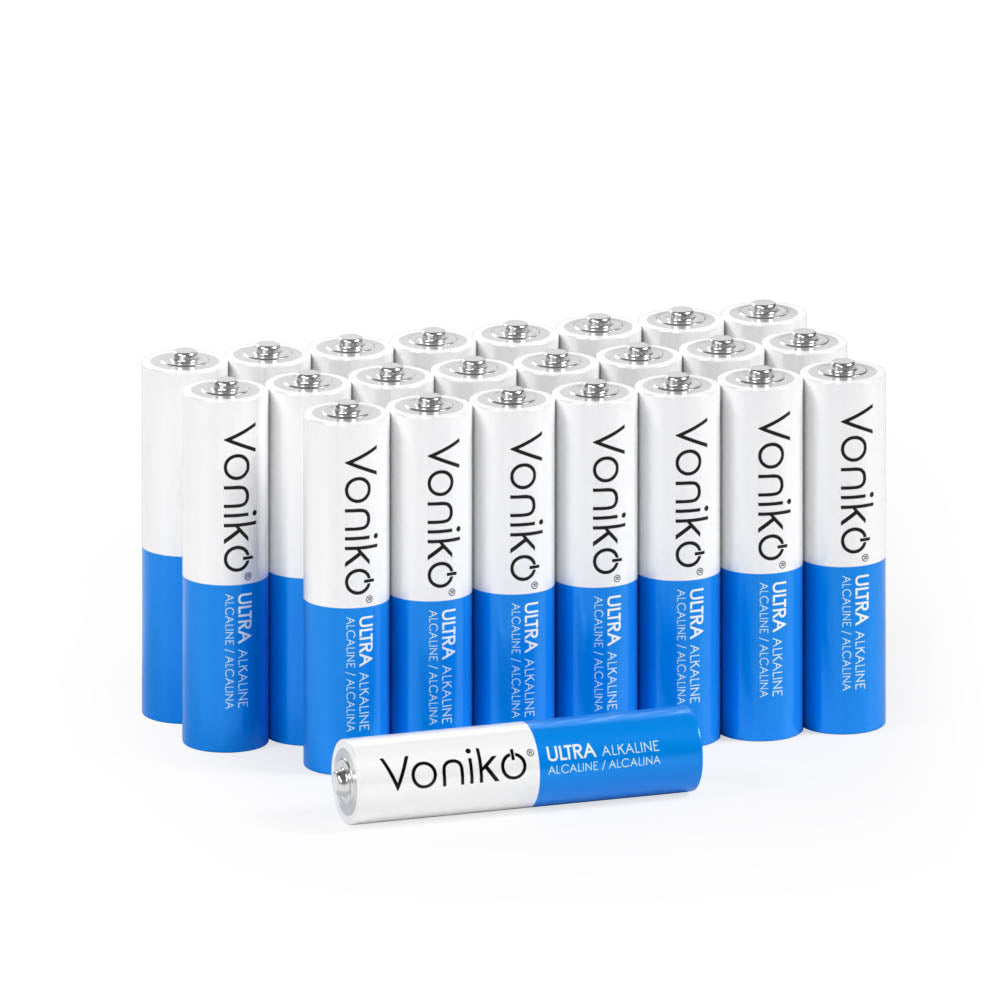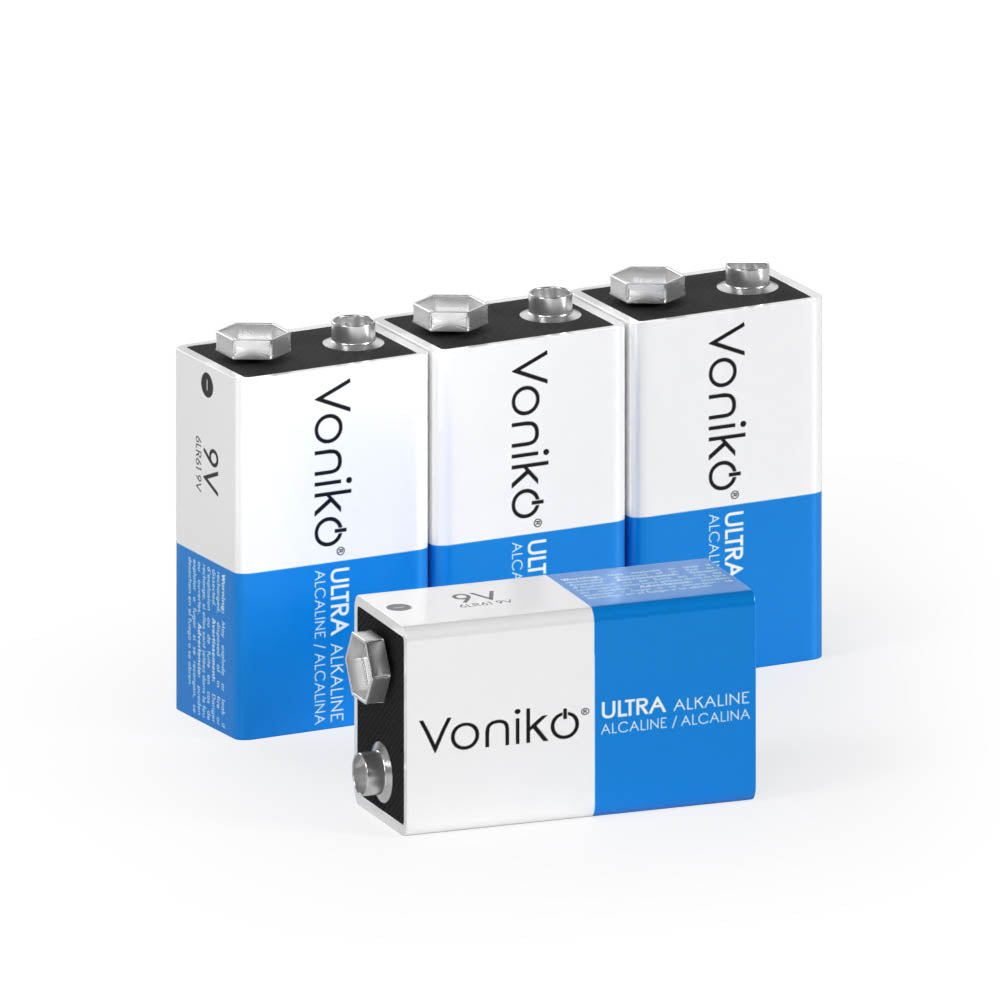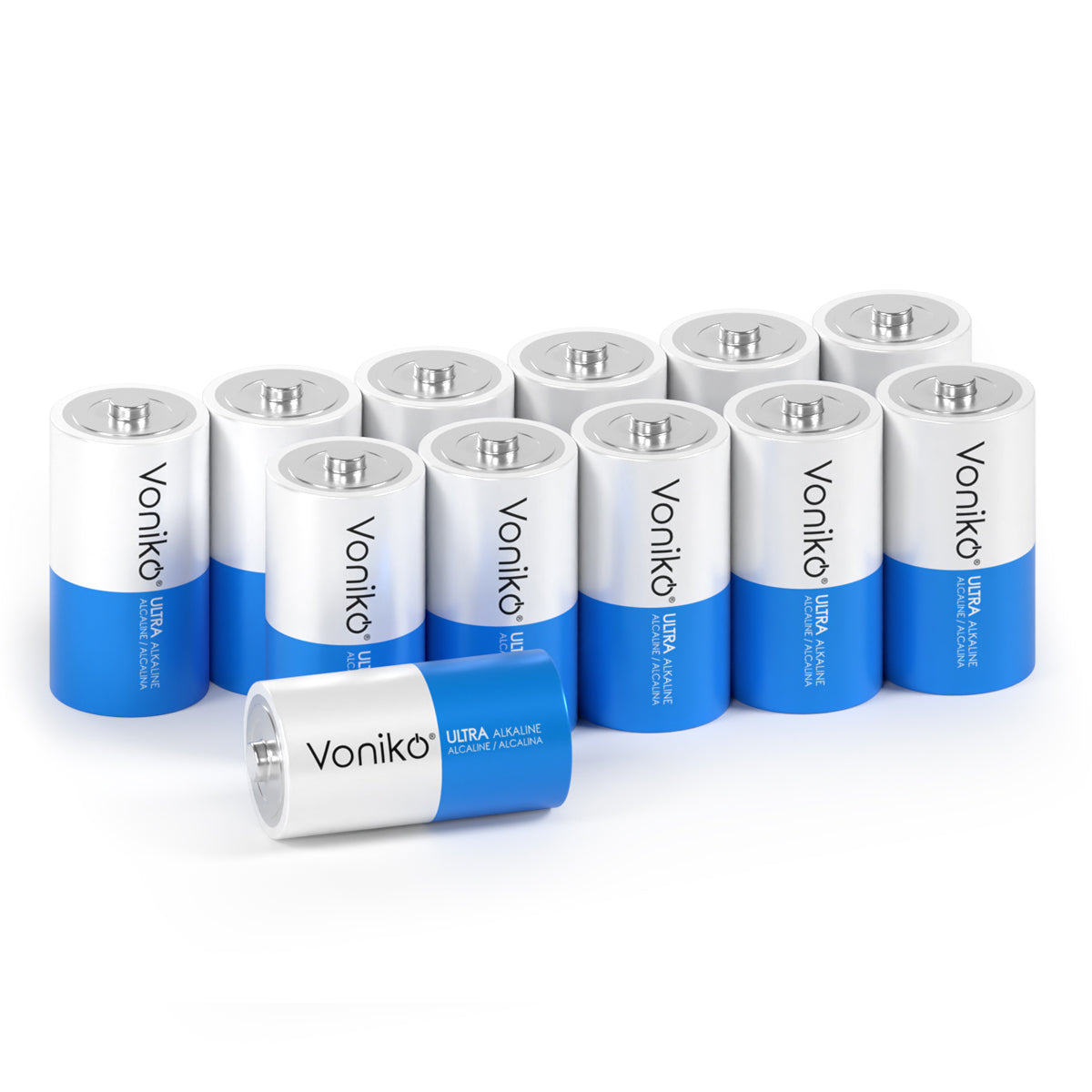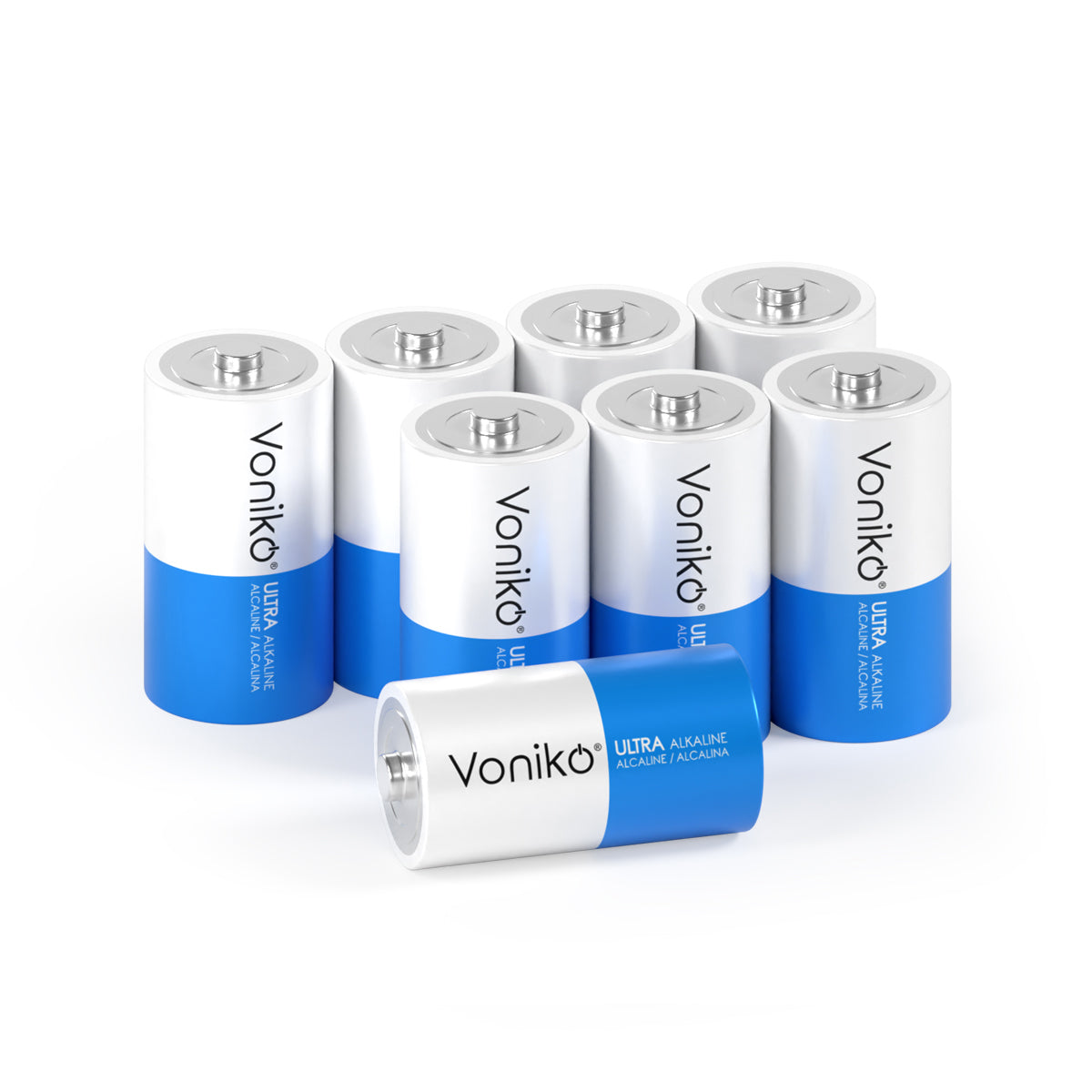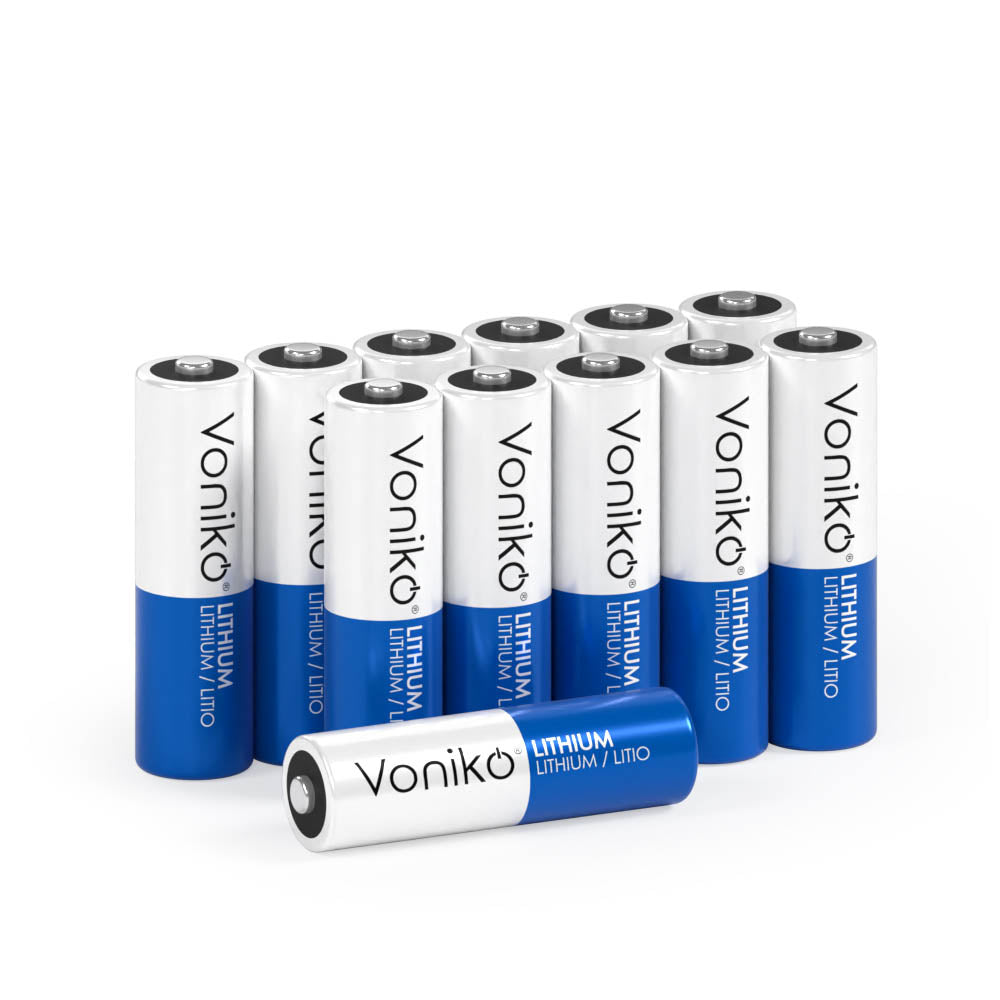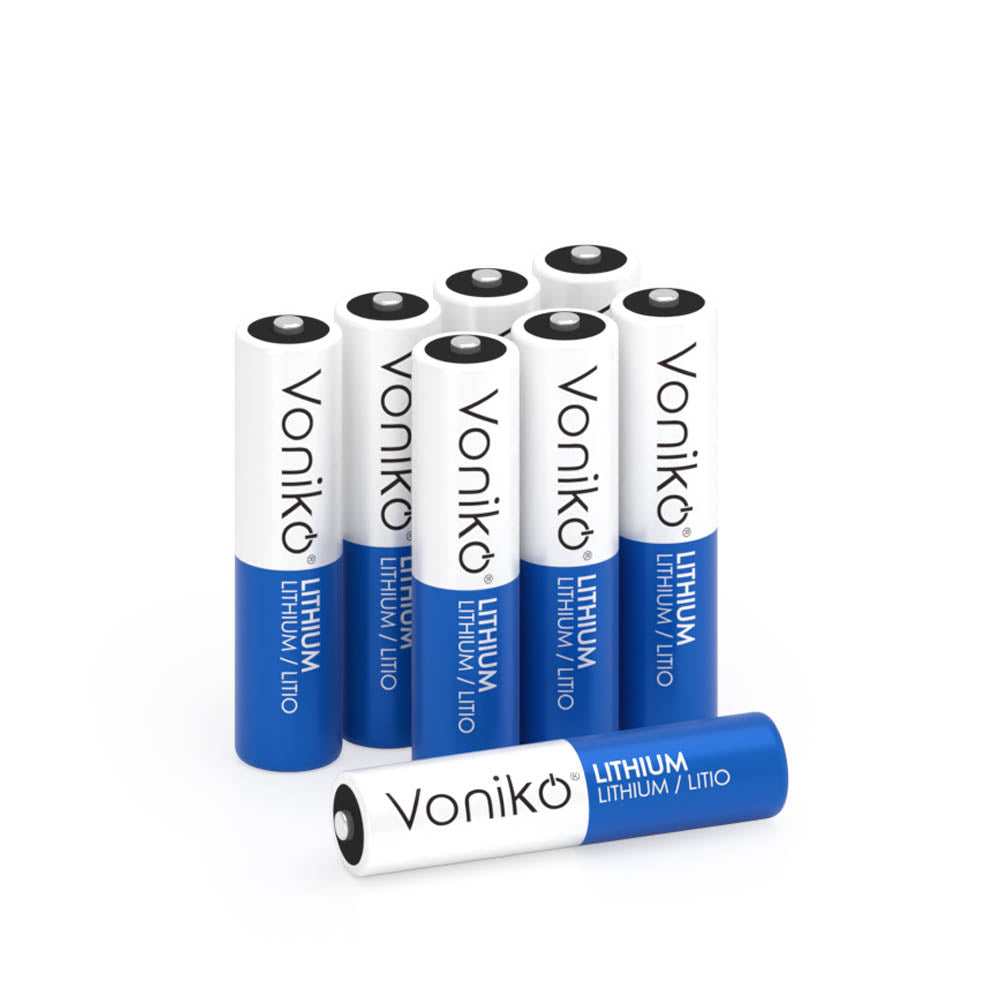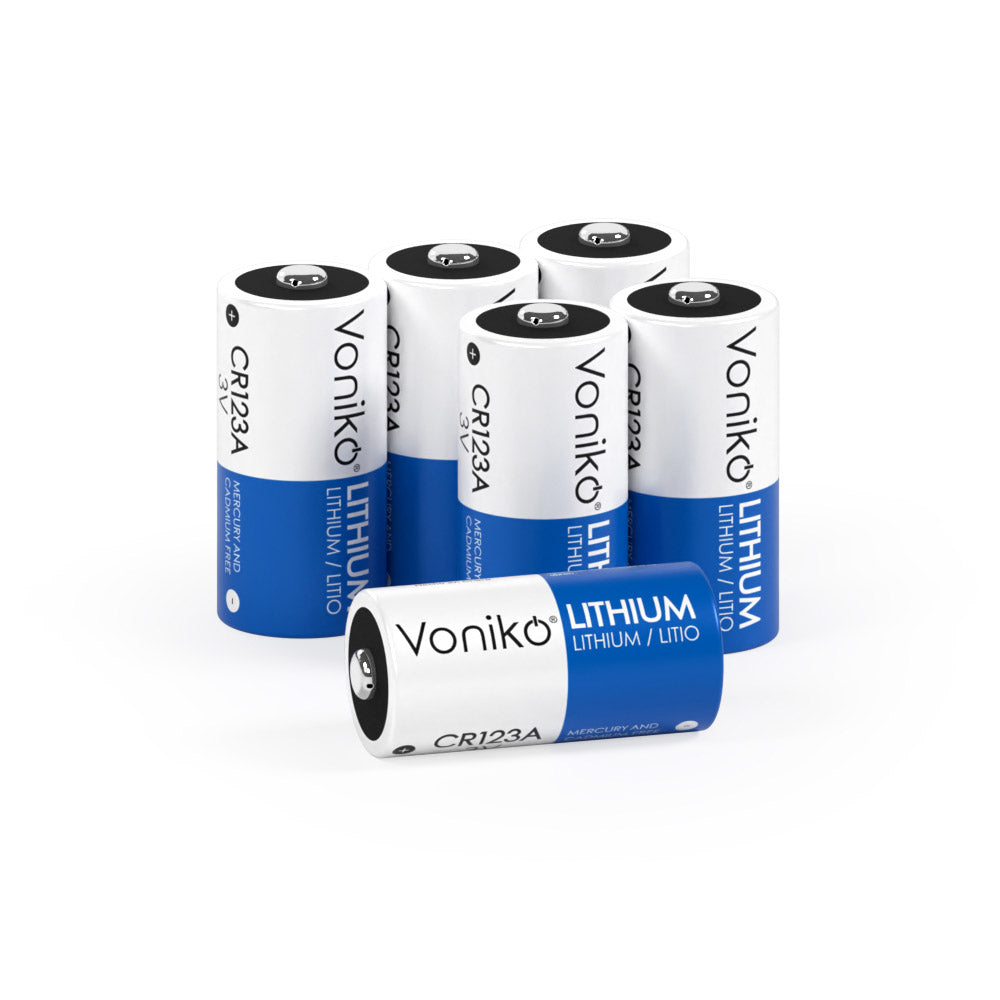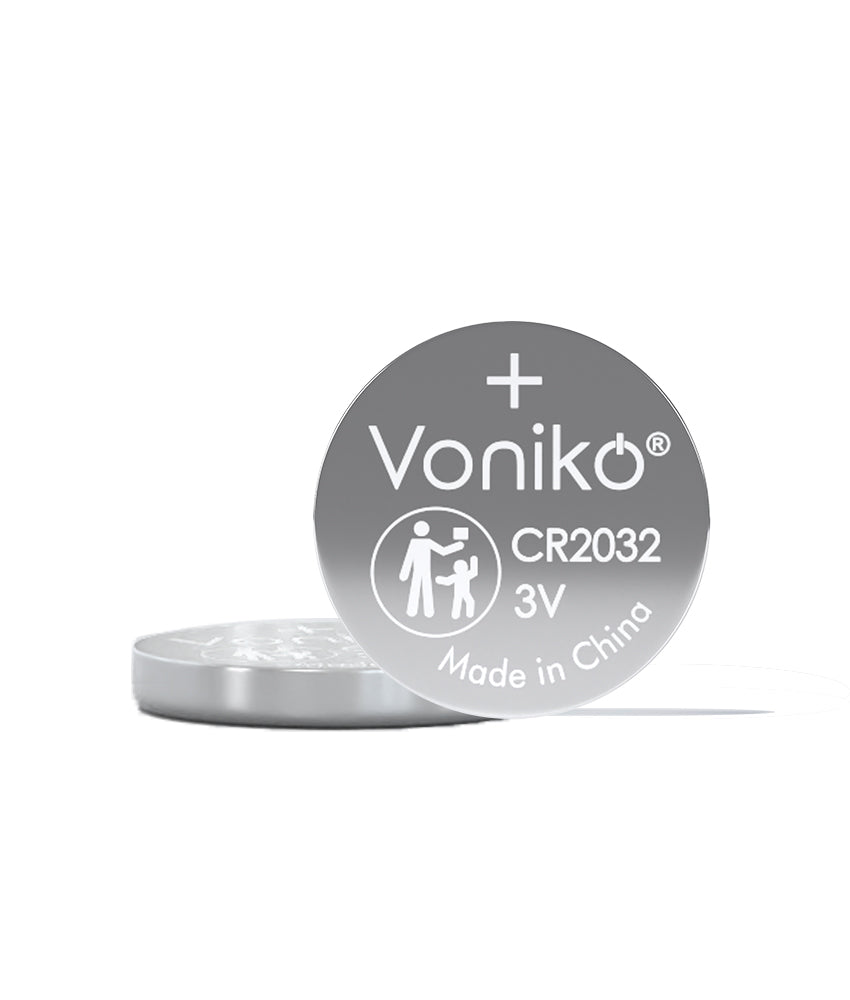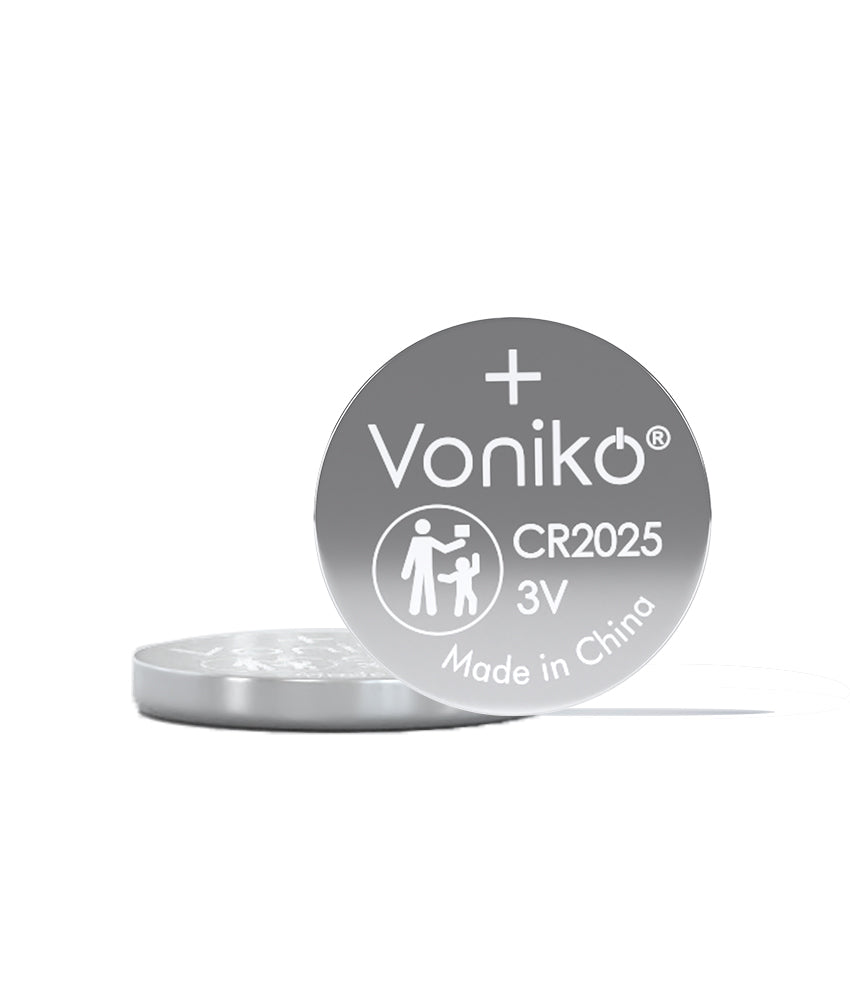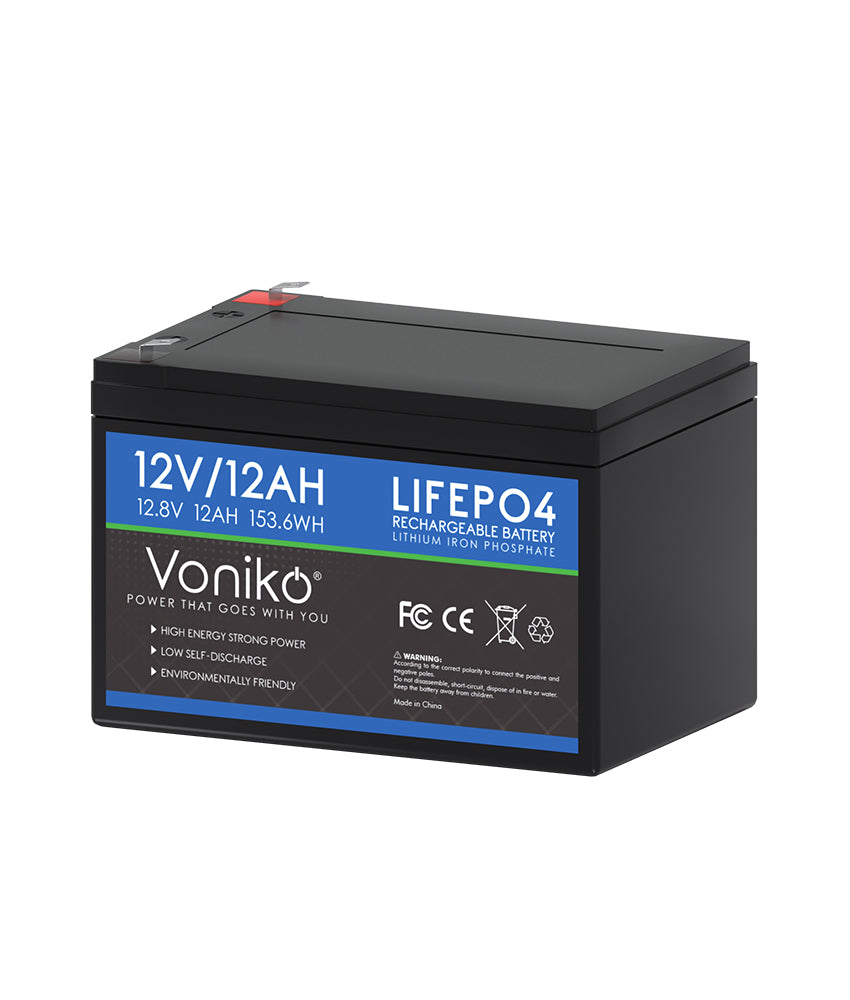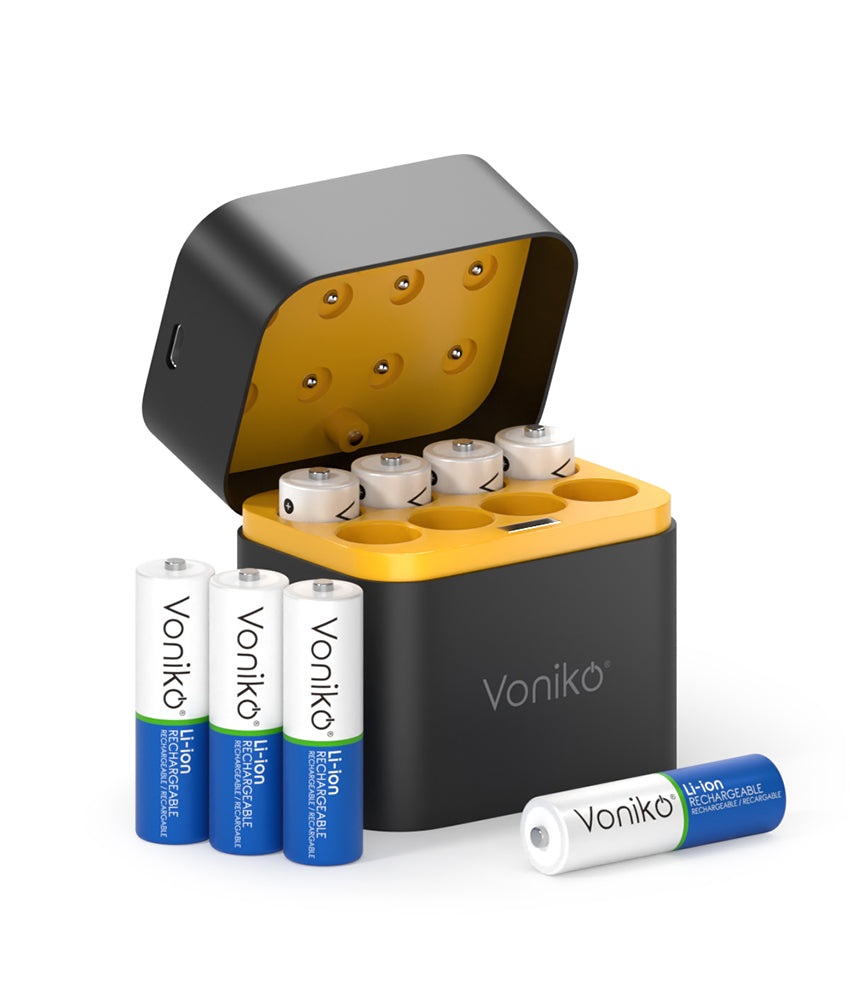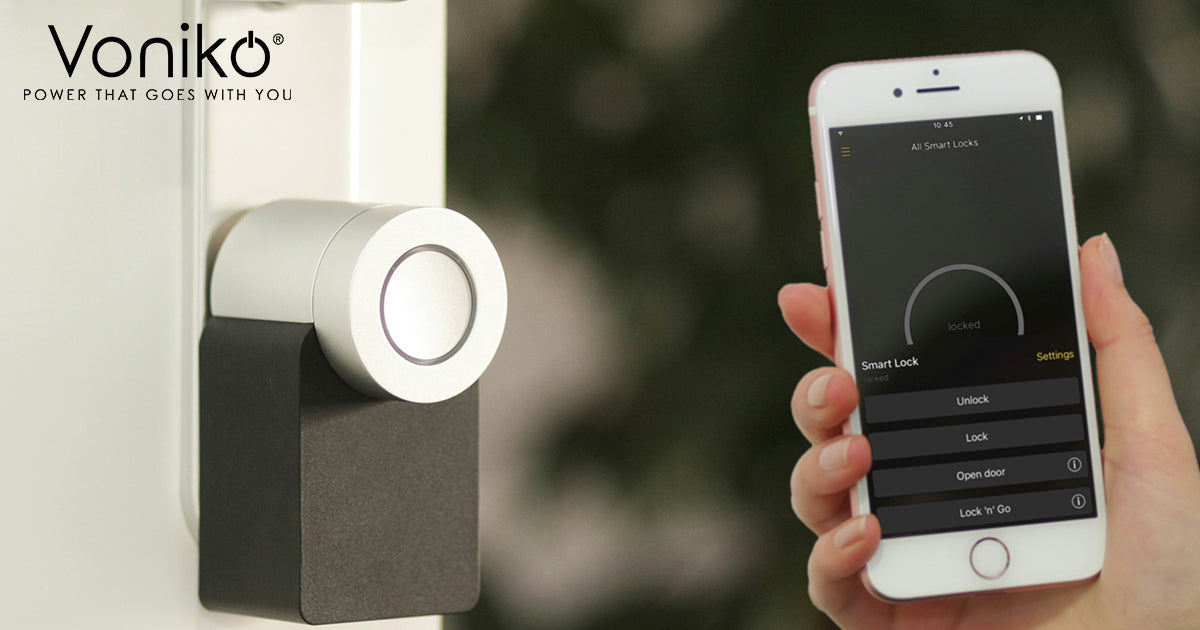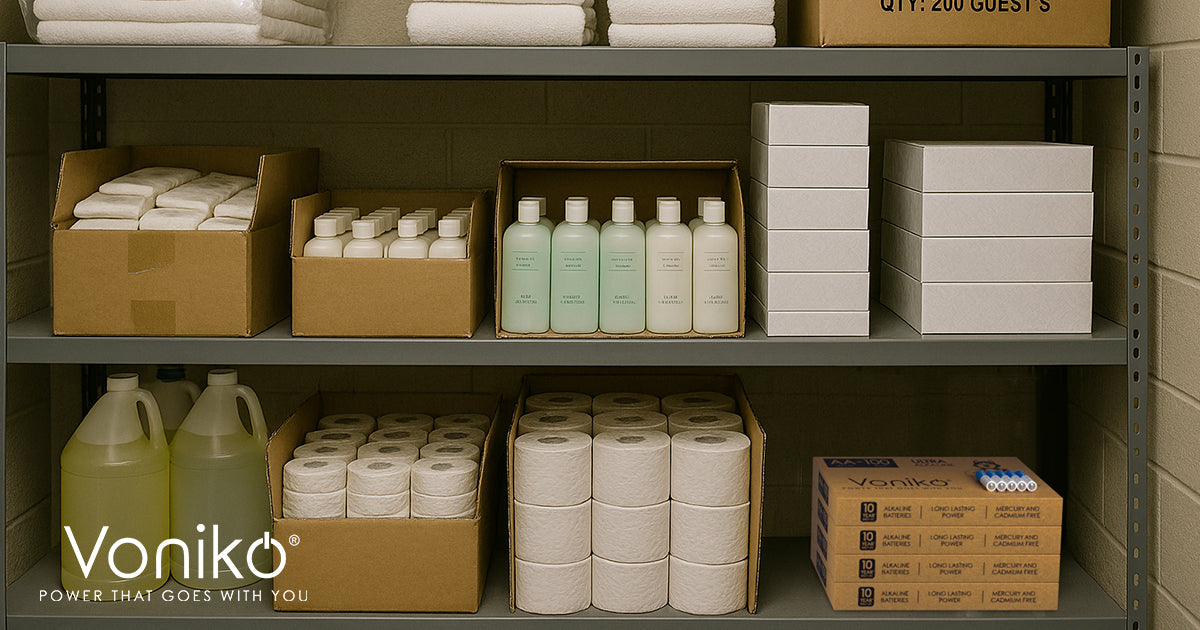This comprehensive testing performance report assesses the Voniko Lithium AA Rechargeable Batteries (1.5V 3300mWh) using professional photography equipment to validate our claims and determine real-world performance characteristics for photography applications. The testing methodology follows international standards including IEC 62133 and IEC 61960, to ensure reliable and reproducible results.
Executive Summary
The Voniko Lithium AA batteries represent an innovative approach to rechargeable battery technology, combining the consistent 1.5V output of alkaline batteries with the rechargeability of NiMH systems. This testing protocol evaluates their performance in professional photography equipment including speedlights, LED panels, and wireless triggers to determine their suitability for demanding photography applications.
Battery Specifications and Features
The Voniko Lithium AA batteries feature several key specifications that differentiate them from traditional battery technologies. The batteries provide a nominal voltage of 1.5V with an effective capacity of 2100+ mAh at standard discharge rates, significantly higher than typical NiMH batteries which operate at 1.2V. The manufacturer claims exceptional cycle life with the ability to retain ≥60% capacity after 400 full charge cycles, making them suitable for professional applications requiring frequent use.
Key features include smart charging capabilities with battery identification systems that prevent charging of non-rechargeable batteries, automatic shut-off when fully charged, and individual LED indicators for each battery. The operating temperature range of -4°F to 131°F (-20°C to 55°C) makes these batteries suitable for diverse environmental conditions encountered in professional photography.
Professional Photography Equipment Requirements
Professional photography equipment places demanding requirements on battery systems, particularly in high-drain applications such as speedlights and LED panels. LED panels require sustained current delivery for extended periods, while wireless triggers demand reliable low-power operation with periodic high-current bursts.
Research indicates that traditional alkaline batteries perform poorly in flash applications due to high internal resistance and voltage drop under load, typically providing only 50-180 flashes compared to 400+ for quality NiMH batteries. The Voniko batteries claim superior performance with 500+ full-power flashes, positioning them competitively against established rechargeable technologies.
Testing Methodology and Equipment Setup
The comprehensive testing protocol consists of eight distinct phases designed to evaluate different aspects of battery performance under controlled laboratory conditions and real-world photography scenarios. The testing follows established industry standards for battery evaluation while incorporating photography-specific requirements.

Comprehensive 8-Phase Battery Testing Timeline for Voniko Lithium AA Batteries
Professional-grade test equipment includes programmable electronic loads capable of 0-30A discharge rates, precision digital multimeters with 6.5-digit resolution, and current clamp meters with 0.1mA resolution for non-invasive measurement during operation. Photography equipment consists of professional speedlights, LED panels, DSLR cameras with battery grips, and wireless trigger systems to simulate actual usage conditions.
Our Battery Testing Equipment Setup
|
Equipment_Item |
Model_Specification |
Connection_Method |
Measurement_Parameters |
|
Electronic Load |
Keysight EL34143A (60A, 150V, 350W) |
USB/LAN to computer, battery direct connect |
Voltage, Current, Power, Capacity, Time |
|
Digital Multimeter |
Keysight 34465A (6.5 digit, 10µV resolution) |
USB to computer, probe leads to battery |
Voltage, Resistance, Temperature |
|
Current Clamp Meter |
Fluke 376 FC (0.1mA resolution, DC/AC) |
Bluetooth to computer, clamp around battery lead |
Current, Power, Frequency |
|
Data Logger |
Keysight 34972A (20 channel, USB/LAN) |
USB to computer, thermocouple inputs |
Temperature, Humidity, Voltage, Time |
|
Temperature Chamber |
Espec SU-641 (-70°C to +150°C) |
RS-232 to computer, battery inside chamber |
Temperature, Humidity, Pressure |
|
Professional Speedlight |
Canon Speedlite 600EX-RT (GN 60) |
4x AA battery compartment, optical trigger |
Flash count, Recycle time, Power draw |
|
LED Panel Light |
Godox LED500C (50W, CRI 96+) |
4x AA battery compartment, manual control |
Current draw, Brightness, Runtime |
|
DSLR Camera |
Canon EOS 5D Mark IV + BG-E20 |
Battery grip with 8x AA, USB tethering |
Battery level, Shot count, Operating time |
|
Wireless Triggers |
PocketWizard FlexTT5 (4-pack) |
2x AA each unit, radio link to camera |
Battery status, Signal strength, Usage time |
|
Computer System |
Dell Precision 5560 + MATLAB/Excel |
All instruments via USB/LAN network |
Data acquisition, Analysis, Reporting |
Environmental testing capabilities include temperature chambers operating from -70°C to +150°C with ±1°C accuracy, enabling evaluation across the full operating temperature range. Data logging systems with 16-channel capability provide continuous monitoring at sampling rates from 1Hz to 10kHz for comprehensive performance analysis.
Detailed Testing Protocol
Phase 1: Initial Capacity Testing
The initial capacity test establishes baseline performance characteristics using controlled discharge at 0.2C rate (approximately 420mA for a 2100mAh battery) to the manufacturer's specified cutoff voltage of 1.0V. This test validates the claimed capacity of 2100+ mAh and establishes the voltage discharge profile characteristic of lithium-ion technology.
Phase 2: High-Drain Flash Performance
Professional speedlight testing evaluates the batteries' ability to provide high-current pulses required for flash operation. Using a Canon Speedlite 600EX-RT set to maximum power, the test measures total flash count, average recycle time, and current draw characteristics until battery depletion. Success criteria require ≥500 full-power flashes with <4-second recycle times.
Phase 3: Continuous Load Testing
Continuous load testing simulates LED panel operation and camera usage with constant current loads ranging from 0.5A to 2.0A. This phase evaluates runtime, voltage regulation under load, and efficiency characteristics critical for sustained photography operations.
Phase 4: Temperature Performance Evaluation
Temperature testing assesses battery performance across the claimed operating range from -20°C to +55°C. Capacity measurements at each temperature point determine the temperature coefficient and validate cold-weather performance claims.
Phase 5: Cycling Endurance Testing
The cycling endurance test employs automated charge/discharge cycling to evaluate long-term capacity retention and cycle life. Following manufacturer charging specifications of 350mA to 1.5V followed by 0.1mA taper, the test continues until capacity falls to 80% of initial rating.
Phase 6: Real-World Photography Testing
Real-world testing scenarios include studio portrait sessions with continuous LED lighting, event photography with rapid flash sequences, and remote wildlife camera trap applications. These tests validate performance claims under actual photography conditions rather than laboratory simulations.
Phase 7: Comparative Benchmarking
Comparative testing against reference batteries including Duracell alkaline, Panasonic Eneloop Pro NiMH, and Energizer Ultimate Lithium provides performance benchmarks. Identical test conditions ensure fair comparison across different battery technologies.
Phase 8: Final Capacity Verification
The final verification phase repeats initial capacity testing to assess degradation from the testing process and establish measurement reliability. Capacity retention >95% indicates minimal testing-induced degradation.
Performance Standards and Benchmarks
Industry benchmarks for AA batteries in photography applications vary significantly by technology type. Alkaline batteries typically provide 2800mAh capacity at low discharge rates. NiMH batteries proviade 2100mAh capacity at high discharge rates, but operate at lower voltage (1.2V nominal).

Voniko Lithium AA Battery Performance vs Industry Standards
The Voniko specifications target 2100+ mAh at 0.2C rate and ≥1800mAh at 1C rate, with internal resistance <100mΩ and peak current capability ≥3A. These specifications position the batteries between alkaline and NiMH in capacity while maintaining alkaline-compatible voltage levels.
|
Parameter |
Units |
Voniko Lithium Rechargeable Specification |
Test Method |
Benchmark |
|
Nominal Voltage |
V |
1.5 |
Digital multimeter, no load |
Alkaline: 1.5V / NiMH: 1.2V |
|
Capacity at 0.2C Rate |
mAh |
2100 |
Constant current discharge to 1.0V |
NiMH: 2100mAh |
|
Flash Recycle Performance |
flashes |
500+ |
Professional speedlight cycling |
NiMH: 400+ |
Data Collection and Analysis Framework
Comprehensive data collection employs automated logging systems recording voltage, current, temperature, and time at 1Hz sampling rate throughout all testing phases. Statistical analysis includes calculation of mean values, standard deviations, and confidence intervals for all measurements, with minimum sample sizes of three batteries per test condition.
Voniko Battery Testing Data
|
Test_ID |
Battery_Serial |
Test_Date |
Temperature_C |
Humidity_RH |
Initial_Voltage_V |
Initial_Resistance_mOhm |
Capacity_0.2C_mAh |
Capacity_1C_mAh |
Flash_Count_Full_Power |
Avg_Recycle_Time_s |
Peak_Current_A |
Energy_Density_Wh_kg |
Voltage_Drop_1A_mV |
Test_Status |
|
VLi-001 |
VLI-AA-001 |
2025-06-10 |
20 |
45 |
1.52 |
85 |
2145 |
1892 |
518 |
3.8 |
3.2 |
152 |
78 |
PASS |
|
VLi-002 |
VLI-AA-002 |
2025-06-10 |
20 |
45 |
1.51 |
88 |
2138 |
1885 |
512 |
3.9 |
3.1 |
151 |
82 |
PASS |
|
VLi-003 |
VLI-AA-003 |
2025-06-11 |
-10 |
30 |
1.53 |
82 |
1501 |
1256 |
362 |
5.2 |
2.8 |
106 |
95 |
CONDITIONAL |
|
VLi-004 |
VLI-AA-004 |
2025-06-11 |
-10 |
30 |
1.52 |
86 |
1495 |
1248 |
358 |
5.3 |
2.7 |
105 |
98 |
CONDITIONAL |
|
VLi-005 |
VLI-AA-005 |
2025-06-12 |
40 |
60 |
1.51 |
89 |
2089 |
1834 |
489 |
4.1 |
3.0 |
148 |
85 |
PASS |
|
VLi-006 |
VLI-AA-006 |
2025-06-12 |
40 |
60 |
1.52 |
84 |
2094 |
1841 |
495 |
4.0 |
3.1 |
149 |
81 |
PASS |
|
VLi-007 |
VLI-AA-007 |
2025-06-13 |
20 |
45 |
1.53 |
87 |
2142 |
1889 |
515 |
3.8 |
3.2 |
151 |
79 |
PASS |
|
VLi-008 |
VLI-AA-008 |
2025-06-13 |
20 |
45 |
1.51 |
83 |
2151 |
1896 |
521 |
3.7 |
3.3 |
153 |
76 |
PASS |
Quality assurance protocols require coefficient of variation <5% for capacity measurements and daily calibration verification for all test equipment. Data integrity measures include automated backup, timestamped entries, and raw data retention for comprehensive analysis and reporting.
Safety Protocols and Considerations
Lithium-ion battery testing requires specific safety protocols due to potential thermal runaway and fire hazards. Testing facilities must include proper ventilation, fire suppression systems rated for electrical fires, and continuous temperature monitoring. Emergency procedures address thermal events, electrical faults, and chemical exposure scenarios.
Battery handling protocols prohibit testing of physically damaged cells and require immediate discontinuation if voltage drops below 0.9V or temperature exceeds manufacturer specifications. Thermal imaging monitoring detects hot spots that could indicate internal failures.
Expected Results and Performance Analysis
Based on manufacturer specifications and industry benchmarks, the Voniko batteries should demonstrate superior capacity retention at high discharge rates compared to alkaline batteries while maintaining voltage compatibility. Flash performance testing should validate claims of 500+ flashes with rapid recycle times, positioning the batteries competitively against established NiMH options.
Temperature performance testing should confirm operation across the specified range with capacity retention ≥70% at -10°C, superior to alkaline batteries but potentially inferior to cold-optimized NiMH formulations. Cycling endurance testing will validate the claimed 400+ cycle life, critical for the economic justification of rechargeable technology.
Applications and Recommendations
The comprehensive testing protocol provides definitive performance data for professional photography applications ranging from studio work to field operations. Results will inform recommendations for specific equipment types and usage scenarios where the Voniko batteries provide optimal performance.
Cost-benefit analysis incorporating initial purchase price, cycle life, and performance characteristics will determine economic viability compared to disposable and alternative rechargeable options. Environmental impact assessment will quantify waste reduction benefits from replacing disposable batteries.
Conclusion
This comprehensive testing protocol provides thorough evaluation of Voniko Lithium AA batteries specifically for professional photography applications. The multi-phase approach ensures both laboratory precision and real-world relevance, delivering actionable insights for equipment manufacturers, professional photographers, and end users. The combination of standardized testing procedures and photography-specific evaluation scenarios establishes a reliable framework for battery performance assessment in demanding professional applications.

